Orionid Meteor Shower - 2023
- Details
- Written by CrystalWind.ca
- Views: 1867
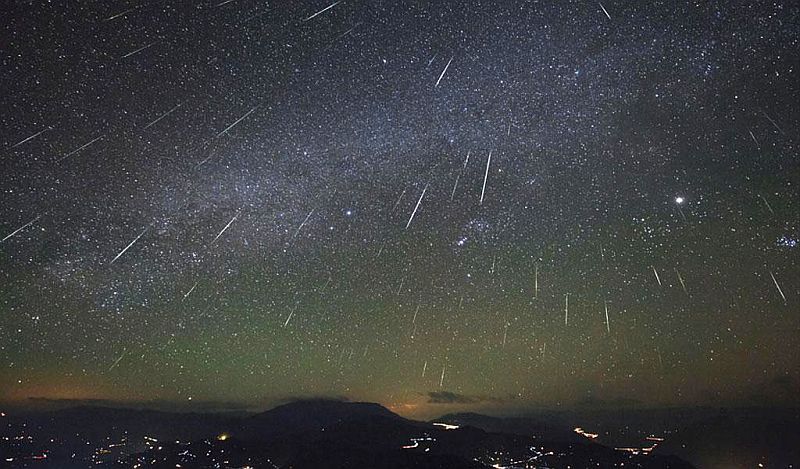
From 2 October to 7 November, the Orionid meteor shower will be active; its peak rate of meteor production will occur around 22 October.
During this period, there's an opportunity to witness Orionid meteors whenever the shower's radiant point, located in the constellation Orion, is above the horizon. The higher the radiant point in the sky, the more visible meteors you can expect to see.
For optimal viewing conditions, note that the shower won't be visible until approximately 22:32 each night, once its radiant point rises above the eastern horizon. The shower remains active until around 07:11 at dawn.
The best meteor displays are anticipated around 06:00 EDT when the radiant point reaches its highest point in the sky. During this time, Earth's rotation aligns favorably, directing meteors vertically downwards, resulting in short trails near the radiant point. At other times, fewer meteors will be visible over the area, and they may enter the atmosphere at oblique angles, generating long-lived meteors that traverse a wide section of the sky before completely burning up.
The peak activity for the shower is expected around 20:00 EDT on October 21, 2023.
Observing the shower's peak
It's projected to produce an average rate of approximately 15 meteors per hour (ZHR). However, please keep in mind that this rate is calculated under ideal conditions of a perfectly dark sky with the radiant directly overhead. Real observation conditions may differ, so the actual number of meteors you see could be lower and can be estimated using the ZHR formula.
The radiant of the shower will reach a peak altitude of 62° above the horizon. Based on this, you might be able to spot up to 13 meteors per hour during the shower's peak.
Notably, the Moon will be in Sagittarius during the shower's peak, at around the first quarter phase. However, it will set at 23:37, posing no interference for observation later in the night.
Experience the Orionid Meteor Shower: Remnants of Halley's Comet.
The particles come from Comet 1P/Halley, better known as Halley's Comet. This famous comet swings by Earth every 75 to 76 years, and as the icy comet makes its way around the sun, it leaves behind a trail of comet crumbs. At certain times of the year, Earth's orbit around the sun crosses paths with the debris.
Typically, this shower delivers around 20 meteors per hour, but during exceptional years like 2006 and 2009, it has rivaled the famous August Perseid meteor shower. This year, astronomer Cooke predicts 30 to 40 meteors per hour. Originating from the constellation Orion, these meteors grace the entire sky.
These meteoroids, offspring of Halley's Comet, blaze through Earth's atmosphere at a staggering 148,000mph (238,000kph), creating brilliant flashes of light easily visible to the naked eye.
The Orionids are renowned for their speed and luminosity, promising those with enough patience a chance to witness several dazzling 'shooting stars' streaking across the heavens.
While Halley's Comet itself hasn't been visible from Earth since 1986, its celestial remnants continue to captivate our night skies."
How to view the show
Orionid meteors grace the night sky, offering a spectacular display visible from every corner of our planet. While they streak across the entire celestial dome, if you locate the iconic constellation Orion the Hunter, you'll find the meteor shower's radiant positioned near Orion's sword. This radiant is situated just slightly to the north of his left shoulder, marked by the star Betelgeuse. However, to optimize your meteor-viewing experience, avoid fixating on this precise point, as meteors originating from the radiant tend to have shorter trails and can be more challenging to observe. Instead, direct your gaze away from Orion for a better chance of spotting these dazzling meteors.
Like many nighttime skywatching experiences, light pollution can disrupt your view of the Orionid meteor shower, especially this year with the added challenge of moonlight interference. To optimize your experience, seek a location far from city lights that may obscure the celestial show. Plan to venture out around 1:30 a.m. and allow your eyes to acclimate to the darkness for approximately 20 minutes. Dress warmly to combat the cold, if necessary. Find a comfortable spot to lie back and rely solely on your naked eyes to observe the sky. Note that binoculars and telescopes won't enhance your view, as they are designed for stationary celestial objects
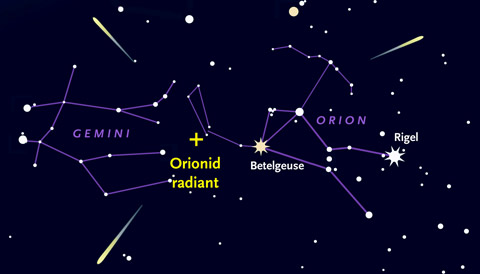
Some Orionids streak across the night sky at astonishing speeds, reaching up to 148,000 mph (238,000 km/h) in relative velocity. This rapid pace is only slightly slower than the Leonids, the fastest meteor shower of the year.
However, it's important to note that the brightness of these meteors doesn't necessarily indicate that they will reach the Earth's surface. These celestial phenomena are known as meteoroids, and they can be as minuscule as a grain of sand. When they enter Earth's atmosphere, they transform into meteors. As they traverse the atmosphere, the friction from air resistance causes them to heat up, resulting in a brilliant and fiery trail commonly referred to as a shooting star. The majority of meteors disintegrate before ever reaching the ground, with only a few exceptional ones being termed meteorites if they do make contact with the Earth's surface.
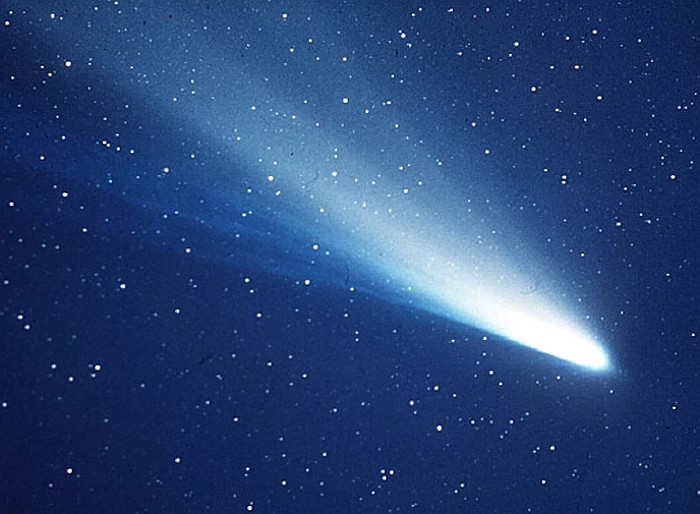
Cometary origins
Astronomers have documented Halley's Comet as far back as 240 B.C., but its recurring nature went unnoticed until 1705 when Edmund Halley, a professor at the University of Oxford, published "Synopsis Astronomia Cometicae" ("A Synopsis of the Astronomy of Comets"). In this groundbreaking work, he provided the first evidence of the comet's return. By meticulously examining historical records of appearances in 1456, 1531, 1607, and 1682, Halley deduced that it was the same comet and accurately predicted its reappearance in 1758, even though he did not live to witness it. The comet was subsequently named after him.
Surprisingly, reports of the Orionid Meteor Shower did not surface until 1839 when an American observer in Connecticut first spotted it. Additional observations occurred during the Civil War between 1861 and 1865. Cooke, an expert in meteor showers, expressed uncertainty about why the discovery of the meteor shower came relatively late, considering the millennia of records regarding Halley's Comet.
The next perihelion, the closest approach of Halley's Comet to the sun, is anticipated around July 2061.
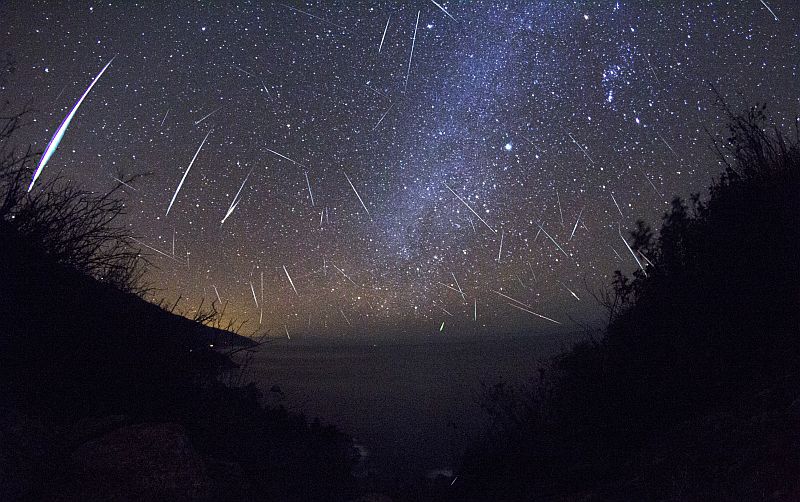
Overall duration of shower: 2 October to 7 November.
The Orionid meteor shower is the greatest one to witness in October. On October 22, when they are at their peak, up to 20 meteors may be seen in the sky in a single hour. The Orionid meteor shower is the greatest one to witness in October. On October 22, when they are at their peak, up to 20 meteors may be seen in the sky in a single hour.
Bottom line: The Orionids will be seen in 2023. Despite being close to first quarter and 37% full, the Moon sets at midnight, leaving the skies dark and the potential for a good spectacle. Have fun!
The sky on 22 Oct 2023
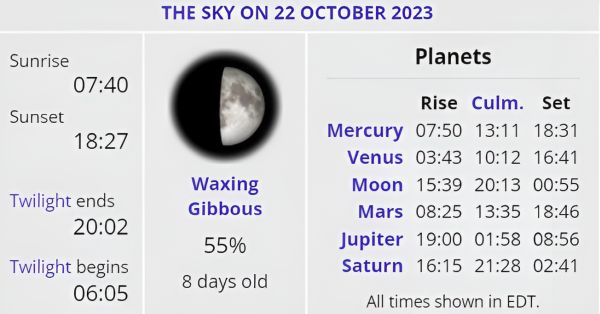
© 2022 crystalwind.ca. All rights reserved. We track all IP addresses with sniffer technology. Using a VPN will not hide your IP.
Liked this article? Dive deeper into personal growth and wellness! Check out CrystalWind.ca for spiritual wisdom or explore AromaWorx.ca for natural well-being tips. Spread the positivity—share this with friends on their happiness journey!
Let’s Chat! Drop Your Thoughts Below! ![]()
Latest Articles
Dive into the Mystical World of the Crystal Wind Oracle Deck!
Get All the Enchanting Details Now!
NEW Expanded Boxed Edition!
Now with 58 Cards for Richer Wisdom!

Imagine a world of inspiration and healing, free for all—made possible by YOU!
Donate Now—Ignite the Magic at CrystalWind.ca!

Epilepsy - Finding A Cure
Your donation can make a difference!
Help us find a cure – donate now!
Unlock Your Light: Join Lightworkers Worldwide on CrystalWind.ca!
Articles: The Founders
Articles: Cosmic Neighbours
Articles: Galactic History
Follow Us!
Featured This Month
Chalcedony
The Stone Of Orators Chalcedony was very popular as a decorative stone in ant... Read more
Cancer Mythology
The Mythology of Cancer: A Celestial Tale of Loyalty and Sacrifice Among th... Read more
Sun in Cancer
Cancer Sun Sign Characteristics Overview The name "Cancer" comes from Latin, ... Read more
Lammas by The Hedgewitch
Although in the heat of a Mid-western summer it might be difficult to discer... Read more
Egyptian Zodiac/Astrology
Egyptian astrology was one of the earliest forms of astrology. The Egyptians w... Read more
Abalone Shell
Echos Of The Ancestors Abalone strengthens the structure of the body and th... Read more
Lugh - Celtic God Of The Sun
The god Lugh was worshiped in Ireland as a deity of the sun. This connection... Read more













































